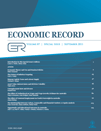The Effect of Motherhood on Wages and Wage Growth: Evidence for Australia*
This work was undertaken while the first author was at the University of Wollongong.
Abstract
Labour market theory provides several reasons why mothers are likely to earn lower hourly wages than non-mothers. However, the size of any motherhood penalty is an empirical matter and the evidence for Australia is limited. This article examines the effect of motherhood on Australian women’s wages and wage growth using a series of panel-data models. Based on data from the Household, Income and Labour Dynamics in Australia survey, an unexplained motherhood wage penalty of around 5 per cent for one child, and 9 per cent for two or more children, is found. Further analysis suggests that the wage penalty emerges over time through reduced wage growth, particularly when the youngest child is an infant, rather than through an immediate wage decline after the birth of a child. This reduction in wage growth is consistent with discrimination, but also with a reduction in mothers’ work effort.




